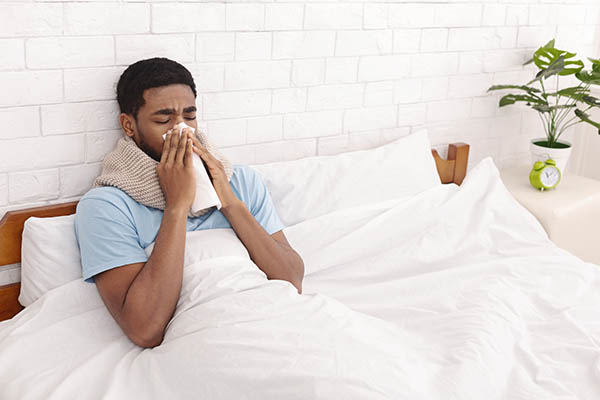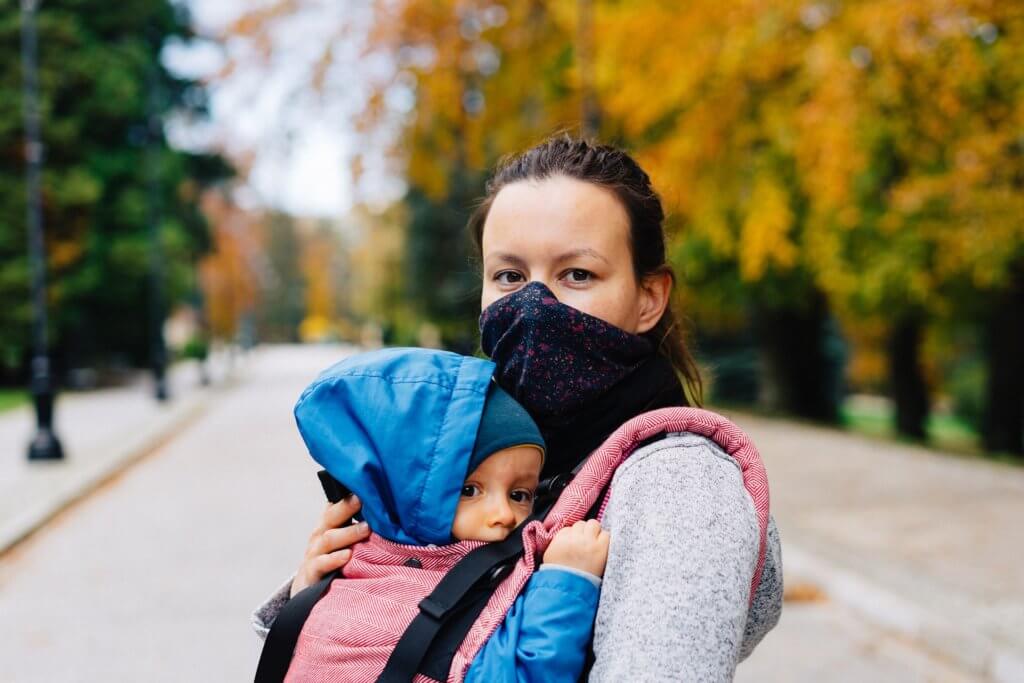Tips to prepare to care for your loved ones with COVID-19 at home

By Stephanie Presch, Content Specialist, Elizabeth Carrillo, Senior Program Manager, and Selene Tituaña Jurado, Program Specialist, UnidosUS
Public health experts are saying that the amount of virus in our community remains high and so does the risk of exposure and infection. This is especially true because of these new coronavirus variants or mutations and most people who become infected do not know how or where they acquired COVID-19.
WHAT TO DO IF A LOVED ONE HAS COVID
What should you do if someone in your family becomes sick with COVID-19? We have provided some tips to help you prepare and manage to care for your loved one at home.
Tip 1. Know the symptoms and get a COVID-19 test.
COVID-19 can present like a cold or flu with runny nose, dry cough, sore throat, tiredness, vomiting, diarrhea, muscle aches, fatigue, headaches, and fever. What seems to be different about COVID-19 is a loss of taste or smell—although not everyone will have this symptom. Symptoms can occur from days two to 14 of infection (or not at all). Be sure to contact your health care provider or your local health department and ask about getting a COVID-19 test, although you do not need a doctor’s prescription to be tested in most communities. Some experts recommend getting a COVID-19 test between days five and seven after exposure.
Tip 2. Be prepared to care for your loved one at home.
In the Latino community, we are more likely to live with our parents, grandparents, or other extended family members in the same household, which makes it harder to practice physical distancing and isolation. In the end, do the best that you can to follow the latest CDC recommendations to reduce your COVID-19 risk when someone in your household gets sick with the virus.
- Limit the spread of infection to other members in the household by separating the sick from the well for at least 10 days; this is called isolation.
- Give your loved one a dedicated space to rest and recoup such as their own bedroom and bathroom if possible. If having their own bathroom is not possible, clean and disinfect the bathroom after each use with disinfecting wipes and toss them in the trash after each use. All persons caring for the sick should wear a layered mask and wash their hands often or use disposable gloves after cleaning or contact with the infected family member’s bodily fluids such as saliva, mucus, urine, or stool.
- The caregiver family member should not be elderly or have high risk conditions for getting very sick from COVID-19 if possible.
- Everyone in your household should wear a layered mask that securely covers their nose and mouth. Masks should not be placed on children under two years old. Keep all household pets away from the infected person.
- If family members or friends outside of your household would like to drop off notes of encouragement or care packages for you and your loved one, please encourage them to wear their layered mask and drop them off. We are sure your loved one will appreciate these acts of kindness and it might even help them look forward to something new each day.
- Avoid close contact like shaking hands or giving hugs or kisses to the person who is sick even if you are wearing a layered mask and encourage others in your household to do the same. Close contact can only increase everyone’s exposure and risk of getting COVID-19. Although this might be hard to do, safety will allow for many hugs and kisses later.
- Do not share eating utensils and other household items like towels. When washing utensils and other household items, make sure you wash them thoroughly with soap and warm water.
- Leave healthy meals and snacks at the entrance of the designated room where your sick loved one is isolating. Be sure to have plenty of fluids like water on hand, as staying hydrated is very important. Remember, you can still make them part of the dinner table and conversations by getting them on a video call. Be creative to make your loved feel they are not alone while they are getting better!

- Encourage your loved one who is sick to cough into their layered mask or elbow or tissue in order to lessen the spread of the virus indoors. Ask them to throw tissue in a designated plastic bag or trash can in their designated room. Tie the plastic trash bag tightly before disposal.
- Quarantine and stay at home as much as possible if you are their caregiver and encourage others in your home to do the same. Look into getting essential items like groceries or prescriptions delivered, if possible, to avoid community spread.
- Ask everyone in the home to wash their hands often and thoroughly with soap and water for at least 20 seconds or the equivalent to singing the happy birthday song twice.
- Use a household cleaner such as soap and water, or diluted bleach to disinfect frequently touched surfaces often to maintain the high touched home surfaces as clean as possible.
- If weather permits, open windows to increase ventilation and fresh air.
- Generally, make sure the person who is sick gets lots of fluids, eats balanced meals, and gets rest. You can also encourage them to do simple body stretches or breathing exercises every day to help them put their minds on something different. Isolating can be difficult for the emotions, so encourage your loved one who is sick to engage in activities they would normally do in a room like watching their favorite programs, reading a book, or staying connected to people by phone or video. Check on your loved ones often to show your care. For more tips, visit CDC webpage on how to cope with stress.
Tip 3. Monitor for worsening illness.
- Have a regular doctor or usual source of health care even if you think you and your loved ones are well at home. This is especially important if someone in your household gets COVID-19 and has a medical condition that puts them at a higher risk of severe illness or health complications.
- It’s helpful to have a thermometer at home. Have your loved one who is sick check the temperature twice daily—in the morning and evening and write it down on paper. Contact a doctor for any fever of 103 degrees Fahrenheit or above.
- It’s also helpful to have a pulse oximeter at home. A pulse oximeter can estimate the blood oxygen level. Remove all nail polish, use it on the middle finger and record the reading several times daily. Most healthy people will get an oxygen reading around 95 to 98%. Most experts recommend contacting a health provider for any reading 93 or lower. An inexpensive pulse oximeter can be purchased at most retail stores or online.
A note about children and COVID-19: Children who are sick with COVID-19 often have symptoms similar to those in adults—fever, cough, sore throat, runny nose, nausea or vomiting, diarrhea, muscle pain, headache, or loss of taste and smell. A small percentage of children develop a more severe condition called MIS-C (Multisystem Inflammatory Syndrome in Children). MIS-C is a condition where different body parts can become inflamed, including the heart, lungs, kidneys, brain, skin, eyes, or gastrointestinal organs. Children with MIS-C may have a fever and various symptoms, including abdominal (gut) pain, vomiting, diarrhea, neck pain, rash, bloodshot eyes, or feeling extra tired. Experts do not yet know what causes MIS-C. However, many children with MIS-C had the virus that causes COVID-19 or had been around someone with COVID-19. Contact your child’s doctor, nurse, or clinic right away if your child is showing symptoms of MIS-C or symptoms of COVID-19. If your child is showing any emergency warning signs including trouble breathing, pain or pressure in the chest that does not go away, new confusion, inability to wake up or stay awake, bluish lips or face, or severe abdominal pain, call 911 or go to the emergency room.
Tip 4. Know when to end isolation.
The CDC advises people who have been sick or tested positive for COVID-19 can be around others after:
- 10 days since symptoms first appeared.
- 24 hours with no fever without the use of fever-reducing medications.
- Other symptoms of COVID-19 are improving* (*Loss of taste and smell may persist for weeks or months after recovery and need not delay the end of isolation.)
Anyone who has had close contact with someone with COVID-19 should stay home for 14 days after their last exposure to that person. People who are severely ill with COVID-19 might need to stay home longer than 10 days and up to 20 days after symptoms first appeared. Persons who are severely immunocompromised (have a weakened immune system) may require testing to determine when they can be around others. Talk to your health care provider for more information.
As we continue to see members of our own community test positive for COVID-19, we want you to be prepared as much as possible on what to do to avoid the spread of the virus from one household member to the next. We understand that taking care of a loved one who becomes sick with COVID-19 can be overwhelming because of the constant news of loss we see in the media. At the same time, we want you to rest assured that having some tips and information of the unknown beforehand can make caring of yourself and your loved ones more doable when someone in your household becomes sick with COVID-19.

UNIDOS US ADVOCACY
UnidosUS has taken an active role in speaking out during the COVID-19 pandemic, from creating a webpage in English and Spanish where people can find information about the virus, to hosting town halls about the impact of COVID-19 on the Latino community, to putting forth recommendations to policymakers—including President Biden—on action that needs to be taken in order to ensure that all Americans can emerge out of the pandemic with the opportunity to thrive. UnidosUS has also recently begun publishing videos on Instagram every week aimed at answering questions that our community has around the rollout of the COVID-19 vaccines.
As the COVID-19 vaccines rollout continues, it’s important for our community to have the information they need to make informed decisions for themselves and their families. Remember that whether you’ve gotten vaccinated or as you wait for your turn to get one of the COVID-19 vaccines, continue to wear a mask, avoid crowds, stay at least six feet from those you don’t live with, and wash your hands often. Hope is on the horizon, but until most people get vaccinated, we must continue to protect each other. Visit our webpage on the COVID-19 vaccines to learn more. Visit the CDC’s webpage for additional information. For resources, got to National COVID-19 Resiliency Network webpage
DISCLAIMER: This content is provided for general information only. It is not intended to be a substitute for professional medical advice, diagnosis, or treatment. Always seek the advice of your physician or other qualified health provider with any questions you may have regarding a medical condition. The ideas expressed solely represent the views of the authors.



